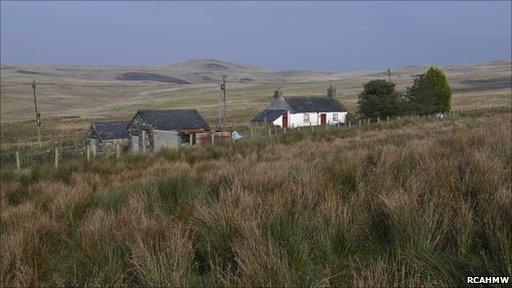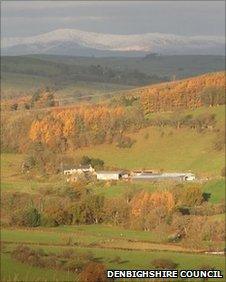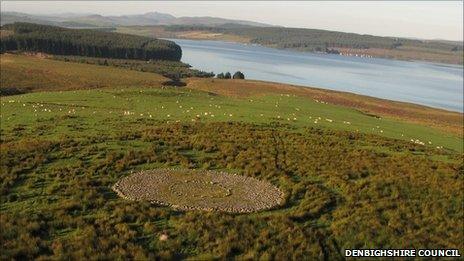Exploring Wales' uplands uncovers Denbigh moors' past
- Published

The old toll cottage on the Denbigh to Pentrefoelas turnpike road
A project to understand the history of Denbigh moors reveals the isolated site was used by man 7,000 years ago.
In fact, while considered remote today, peat samples show it was intensively farmed in the 1100s, according to experts.
Their findings have just been published in the first overview of a 20-year project to explore Wales' least known places, its upland countryside.
More reports are expected to follow covering the other uplands of Wales.
Today, they are said to "lie at the very limits of farming and settlement", but that was not always the case, according to specialists at the Royal Commission on the Ancient and Historical Monuments of Wales (RCAHMW).

Looking towards Mynydd Hiraethog at Glan yr Afon
The discovery of flint tools on Denbigh moors, also known as Mynydd Hiraethog, shows the area has been used by man since at least 5000 BC.
And important funerary and ritual monuments which can still be seen near Llyn Brenig are said to show its importance in the Bronze Age period.
Shooting lodge
David Leighton, a field monument investigator and manager of the uplands project, contributed to the book, Mynydd Hiraethog: The Denbigh Moors, which makes all the findings public for the first time.
He says the uplands study was started to understand Wales' higher ground as, previously, little was known as such areas are the least populated in Wales.
And, with the locations being used by industry such as forestry, quarrying and more recently wind farms, it was important to record and protect important areas and habitats.
The remains of round houses near Llyn Alwen and at Graig Fechan near Pentre Llyn Cymmer show people have been living in the area for thousands of years.
As part of the study, peat core analysis found that during the period 1180-1280 the landscape was dominated by rich grassland as well cultivated cereal crops like oats and barley.
During this period the monastic movement used great swathes of land and the specialists think a possible monastic grange can be seen at Hen Ddinbych near Llyn Brenig.

A modern cairn at Lake Brenig where Bronze Age artefacts were discovered
The moors continued to be used for agriculture throughout the medieval and early modern period with evidence of summer dwellings found across the area.
During the 19th Century the moors were used by large estates for hunting and shooting, as can be seen in the ruins of a shooting lodge at Gwylfa Hiraethog.
Other uplands studies by the RCAHMW are in various states of completion looking at the history of Snowdonia, the Berwyns, Cambrian Mountains, Brecon Beacons and Radnorshire.
- Published11 May 2011
- Published10 April 2011
- Published4 March 2011
- Published24 June 2010